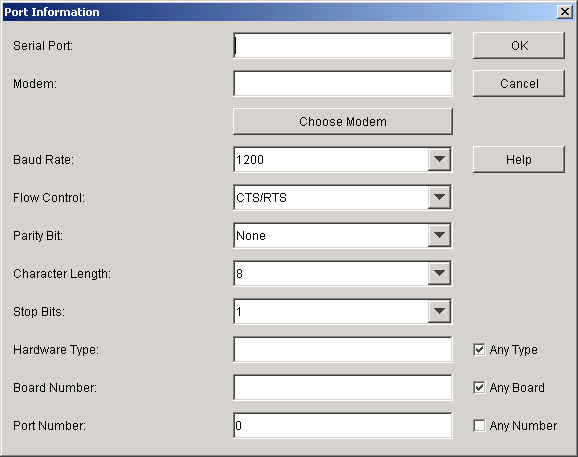Defining Ports for Modems
The port definition sets the properties of the gateway server's serial ports, including any changes made available if you installed a multiport serial expansion card. These properties are mandatory, and must be defined before the gateway will operate.
To define ports for modems:
-
In ConsoleOne®, browse to and select the Domain object where you created the Async Gateway.
-
Right-click the Async Gateway object, then click Properties to display the Ports page.
-
Click Create to display the Port Information page.

The information you provide on the Port Information page defines the parameters of the gateway server's serial ports, including any made available if you installed a multiport serial expansion board. Check each field to make sure it contains the correct information for your system.
If you have configured multiple serial ports, you must fill in the Port Information page for each serial port.
-
Fill in the fields (worksheet item 3):
Serial Port: Specify a unique name for the serial port.
Modem: Click Choose Modem, then select the modem definition for the serial port connection.
Baud Rate: In the drop-down list, select the baud rate that matches the baud rate of the modem you plan to connect to this serial port.
Flow Control: Use the default value CTS/RTS.
When you initialize your modem, check the initialization string to make sure it is configured for the type of flow control you select in this field.
Parity Bit: Keep the default of None unless you are connecting to a system that requires an extra bit to make the sum of bits odd or even.
Character Length: Keep the default of 8 unless you are connecting to a system that does not support an 8-bit data path.
Stop Bits: Keep the default of 1 unless you are connecting to a system that uses 2 stop bits.
-
If you have installed the NetWare® Async Gateway, fill in the following additional fields (worksheet item 4):
Hardware Type: If you have only one serial port, keep the default of Any Type. If you have an multiport expansion board, provide the hardware type for the one you are currently configuring.
Board Number: If you have only one serial port, keep the default of Any Type. If you have multiple serial ports, provide the board number for the one you are currently configuring.
Port Number: If you load only one communication port driver, keep the default of Any Number. If you load a single multiport communication driver (such as aioicomx.nlm), provide the port number for the one you are currently configuring.
-
Click OK to save the port and modem information.
-
Click OK to save the updated list of ports.
-
Continue with Defining a Domain Connection.